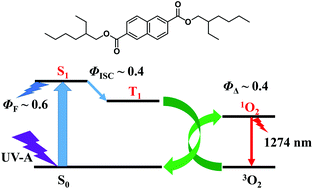Photophysical properties of diethylhexyl 2,6-naphthalate (Corapan TQ), a photostabilizer for sunscreens†
Abstract
Diethylhexyl 2,6-naphthalate (DEHN, tradename Corapan TQ) is used as a photostabilizer for a widely-used UV-A absorber, butylmethoxydibenzoylmethane (BMDBM). The photophysical properties of DEHN have been studied through measurements of the transient absorption, fluorescence, phosphorescence and EPR spectra in ethanol. The energy level of the lowest excited singlet state of DEHN is higher than that of BMDBM (enol form). The singlet–singlet energy transfer from BMDBM to DEHN is energetically unfavourable. The energy level of the lowest excited triplet (T1) state of DEHN is lower than that of BMDBM. It is probable that the mechanism of photostabilization of BMDBM by DEHN is the triplet–triplet energy transfer from BMDBM to DEHN. The observed phosphorescence spectrum, T1 lifetime and zero-field splitting parameters indicate that the T1 state of DEHN can be regarded mainly as a locally excited 3ππ* state within naphthalene. The sum of the quantum yields of fluorescence of DEHN (0.59 ± 0.09) and singlet oxygen generation by DEHN (0.44 ± 0.04) is almost unity in ethanol. About 60% of the UV energy absorbed by DEHN is released as fluorescence, while about 40% is used to produce the excited triplet state. The photoexcited states of 2-naphthoic acid have been studied for comparison.



 Please wait while we load your content...
Please wait while we load your content...